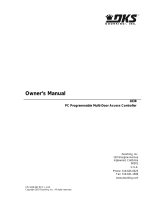
Installation
Wiegand Access Controller
Connection
Power
DoorKing Part Numbers
To Receiver Terminal #1 (Neg.)
To Receiver Terminal #2 (Pos.)
12-24 Volt
Transformer
DC Polarity Matters!
Removable receiver
terminal for
easy
wiring.
8040-080
318 MHz
Use with MicroPLUS or MicroCLIK
Transmitters
8040-081
Use with MicroCLIK 418 MHz
Transmitters ONLY
Separate Power Source:
(Provides greater range.)
Connect 12 - 24 Volt AC or DC power
to terminals #1 and #2.
Use minimum 18 AWG wire to power
the receiver.
• If DC power is used (Transformer):
Terminal #1 is NEGATIVE and terminal
#2 is POSITIVE.
• Power can be supplied to the receiver
by the wiegand access controller
instead of a separate power source.
#1 - Input Power Common (Negative)
#2 - Input Power
12-24 Volt AC, 12-24 Volt DC (Positive)
#3 - Relay N.O. Normally Open
#4 - Relay N.C. Normally Closed
#5 - Relay Common
#6 - Wiegand Common
#7 - Wiegand Data 0
#8 - Wiegand Data 1
(Red Wire)
(Black Wire)
(Green Wire)
(White Wire)
MODEL 8040 MicroPlus
®
/ MicroClik
®
RF RECEIVER
MicroPlus
®
Transmitters
MicroClik
®
Transmitters
Over 286,000,000 transmitter codes available plus an encrypted sync code (often called a “rolling code”) that changes every time the transmitter is
used. Available in 1 – 2 – 3 – 4 button versions, 318 MHz only. MicroPlus
®
transmitter codes cannot be copied assuring that only the original
intended transmitters will activate the access control system.
As such, MicroPlus
®
transmitters are not compatible with the
HomeLink
®
system found in many automobiles.
Over 1,000,000 transmitter codes available. Available in 1 – 2 – 3 button versions, 318 or 418 MHz. MicroClik
®
transmitters are compatible with
the HomeLink
®
system found in many automobiles.
1
2
3
4
5
6
7
8
Program
L
ED
Receiver
Te
r
minal
Be sure the
antenna, coax
shield and F
connector are
completely
isolated from
the ground.
F Connector
Wiegand Access Controller Wiring:
Receiver terminal #2 is INPUT POWER (12-24 V).
Receiver terminal #6 is wiegand input power COMMON.
Receiver terminal #7 is wiegand DATA 0.
Receiver terminal #8 is wiegand DATA 1.
NOTE: Terminals #1 and #6 MUST be wired together if NOT using a separate power source.
Use 22 AWG shielded wire, maximum 200 feet, for wiegand access controller wiring.
Connect these terminals to the corresponding terminals on the wiegand access controller.
Refer a DoorKing wiegand access controller installation manual for specific wiring information.
1
2
3
4
5
6
7
8
9
A
B
C
D
E
F
1
Button
2
Button
3
Button
MicroClik
®
Transmitters
This receiver is NOT designed to be installed outdoors without
being protected from the weather. An outdoor enclosure is available
for the receiver if required, (P/N 8057-110 - Metal Outdoor Box).
Install the 8040 receiver in a location so the antenna is NOT
surrounded by metal and is in free air as high as possible above
the ground. A longer Coax Antenna kit is available for the receiver if
required (P/N 1514-073 - Includes antenna, mounting “L” bracket
and 15 feet of coax cable). An antenna amplifier kit (P/N 8052-080)
or a Yagi directional antenna kit (P/N 1514-072 -318 MHz ONLY) is
also available for the receiver if greater range is required.
The Program LED on the side of the case will blink as RF energy
is received. If the program LED blinks or is on continuously, this
indicates that there may be interference on the frequency
(318 MHz) and short range may be the result. If this happens, try
relocating the receiver or remove the source of interference.
An antenna amplifier or a directional antenna may be needed.
Coax
Antenna
Kit
(Included)
DO NOT use.
26, 30 or 31-Bit
Wiegand Access
Controller connection.
18”
Coax
Cable
The model 8040 receiver is a versatile RF receiver that can output received transmitter codes in 26, 30 or 31-bit wiegand
format allowing it to be used with most access controllers, or it can be used as a stand-alone receiver using its built-in
Form C (NO, NC, C) dry contact relay. A “Master” transmitter can be setup and used to quickly put the RF receiver into
“Learn Mode” to program additional transmitter codes.
The 8040-080 receiver operates at 318 MHz and can be used with both MicroPlus
®
and MicroClik
®
transmitters set to this
frequency. The 8040-081 receiver operates at 418 MHz and can ONLY be used with MicroClik
®
transmitters set to this
frequency.
8069
1
Button
8070
2
Button
8071
3
Button
8096
4
Button
MicroPlus
®
Transmitters
8066 8067 8068
Jumper, See note.
1
8040 065-K-9-19





